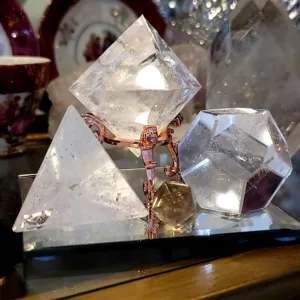
“There is Geometry in the humming of the strings, there is music in the spacing of the spheres” – Pythagoras

There are very few who can ignore the beauty of nature. The golden glow of a sunset, the crashing of waves on the beach. However, most of us are unaware that the basis of this beauty lies in geometric forms, the building blocks of nature or “Sacred Geometry”. All around us we see hexagons in a beehive and a snowflake, the spheres of the planets, the spiral in a seashell, flowers, and plants. Nature is Geometry.
So, what is Sacred Geometry? It is the study of regularly recurring shapes that occur naturally in the world around us. Ancient philosophers such as Plato and Pythagoras believed them to be the building blocks of the world around us, and evidence of a higher power, or Divine Creator. The mathematical patterns are repetitions of simple natural laws, and each carries specific meaning and energy.
Sacred geometry has been applied in disciplines such as architecture, art and religion, and energetic practices such as reiki, yoga, crystal healing, Bio Geometry and others. Whether we realize it or not, Sacred Geometry is intricately woven into our everyday lives.
~
“There is more godliness in nature than in anything built by man.”
– Ralph Waldo Emerson
~
What Are the Shapes?
The Five Platonic Solids
There are many shapes encompassed within Sacred Geometry, but there are five basic shapes known as the Platonic Solids (named after Plato), which we will focus on today. Each represents one of the elements: earth, wind, fire, water and Aether, or the Universe.
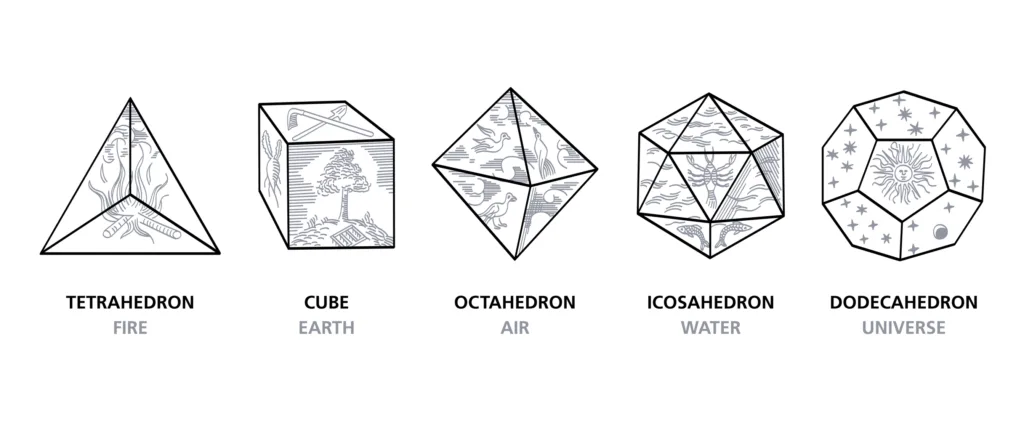
Closely related to the Platonic Solids is the flower of life. This grid holds within it all the points of the geometric shapes – they all exist and are drawn from within the Flower of Life.
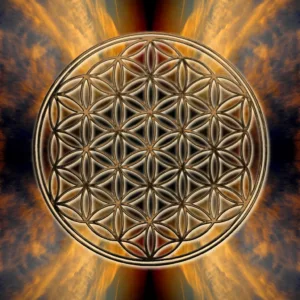
An additional connection is Metatron’s Cube – when all shapes are superimposed over one another, they create this beautifully complex shape, which is believed to be the blueprint of creation. Named after the Archangel Metatron, who keeps records in the book of Life, the Platonic Solids are both individual and part of the whole.
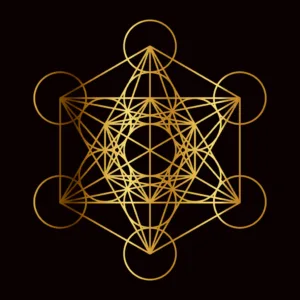
~
The Platonic Solids
~
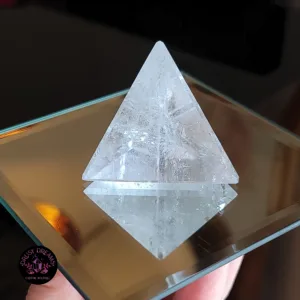
4 faces, 4 points, 6 edges
TETRAHEDRON
The Tetrahedron represents the fire element and has 4 faces, 4 points, and 6 edges. With its sharp points and edges, Plato assigned this shape to the fire element.
As the simplest of all the Platonic Solids, the tetrahedron represents individuality. It also represents upward ascension, the balance between male and female energies, and as the fire element, it represents change and transformation. Each face has three sides, which is the number representing Divinity. It has a total of four faces, which is the number representing humanity. This translation represents the spark of Divinity within us all.
In the crystal world, this shape is seen in the crystal structure of both quartz and Tourmaline.
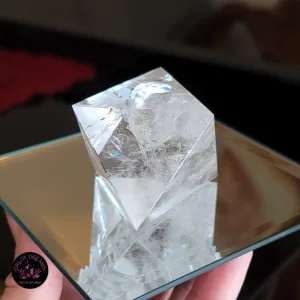
8 faces, 6 Points, 12 edges
OCTAHEDRON
The Octahedron shape represents the air element. It has 8 faces, 6 points, and 12 edges, placing it between the fire and earth elements. Plato assigned it to the air element due to its lightweight and ethereal nature.
The Octahedron symbolizes a bridge between the earthly and celestial realms, or the physical and metaphysical. It resonates with knowledge, mental clarity, intuition and obtaining wisdom – in short, the all-knowing connection to higher realms.

6 faces, 8 points, 12 edges
HEXAHEDRON (Cube)
The Hexahedron shape represents the earth element. It has 6 faces, 8 points, and 12 edges. Solid and grounding. Plato assigned this shape to represent stability and the earth we live on. Each face is a 4-sided square, the number representing humanity. The hexahedron is thus connected with our physical experiences and reminds us of our potential for spiritual growth through practices such as meditation.
In the crystal world, this shape is naturally occurring in minerals such as Pyrite and Fluorite.

20 faces, 12 points, 30 edges
ICOSAHEDRON
The Icosahedron shape represents the water element. It has 20 faces, 12 points, and 30 edges. This shape has the most sides and points of all the platonic solids. like water, it is the most dense, blunt and flexible. Water can take different forms (ice, snow, vapor, etc.) and this can be compared to our emotions. Represented by the water element, human emotions are never-ending and quite complex. This symbol is about transformation – it reminds us to go with the flow and promotes movement and change.
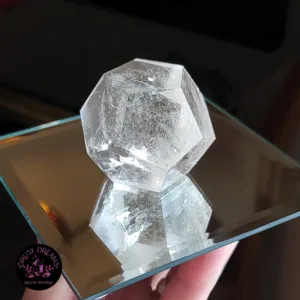
12 faces, 20 points, 30 edges
DODECAHEDRON
The Dodecahedron shape has 12 faces, 20 points, and 30 edges. With its 12 faces, Plato assigned the dodecahedron to represent the Heavens with its 12 constellations. Also known as the Aether element – in Greek mythology, this is believed to be the pure air that the Gods breathed, synonymous with the heavens. This is the fifth element, a binder that holds all other elements together and within it.
In the crystal world, we see Dodecahedrons in Garnets.
~
“Geometry is the archetype of the beauty of the world.”
– Johannes Kepler
~
~ Prefer Video? ~
What are your experiences or thoughts about Sacred Geometry? We’d love to hear! Leave a comment below 👇
Looking for Sacred Geometry Crystals? Our stock is always changing; check our current inventory HERE
Additional Information:
This article was intended as a brief overview. If you are interested in learning more about Sacred Geometry, here are some of my favorite resources, including references linked above:
Encyclopedia Brittanica – Platonic Solids
Bartholemew (Architecture)
Satya Center – Sacred Geometry and Quartz Crystals
A Higher View (Recommended Blog)

